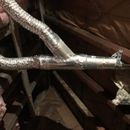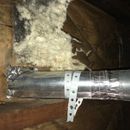Insulating bathroom exhaust ducts
Hi all,
I’m deep in a project insulating my cathedral attic. I’ve gotten a lot of great guidance from this site. Most recently, I was advised to seal off the gable that juts off of the main attic space and covers the bathrooms. This would create a ventilated space above the bathrooms that would help provide ventilation to the connecting roof face (since there was no soffit venting there for intake air). I’m following this advice, which will involve air sealing and insulating the attic floor in this gable section and then making sure the soffit and ridge vents are opened up.
As you will see in the photos, there is some duct work connecting the exhaust fans from the two bathrooms below to a penetration in the roof. When I was in there earlier today, I noticed some water pooled below one of these flexible pipes. I don’t see any sign of roof leaks and so I think there is a small leak in the flexible pipe that is allowing condensate out. The ductwork is less than 2 years old, and this is the first time I’ve seen any water like this. I’m thinking of redoing the ductwork.
1. Should I redo the ductwork with as much rigid piping as possible or is the flexible piping safe to use?
2. Should I insulate the ductwork (it will now be in an unconditioned, vented space once I seal it off)? I saw that they make insulated flexible tubes.
Thanks,
Matt
GBA Detail Library
A collection of one thousand construction details organized by climate and house part












Replies
If you want to meet code, you need to insulate those ducts. Exhaust fan ducts in attics are supposed to be insulated. You can get insulated ducting for this purpose, and you can also get tubular insulation “socks” that slide onto uninsulated ducts to insulate them. I recommend against using the spiral insulation wraps because they are just a pain to install, especially in a confined space.
You are correct that it will be best to replace the flexible duct with rigid duct. You lose a lot of performance in terms of reduced airflow when you use flexible ducting. Do it the right way now while you’re up there and you won’t have to fix it later :-)
Bill
The issue is the lack of insulation. Insulate the ducts and you won't have issues. I find going with semi rigid aluminum pipe with an insulated sock over it the easiest when working in tight spaces. Slightly more restrictive than rigid pipe but easier to connect things.
You can have one fan for 2 bathrooms, but you should not use one vent for two fans. When you redo your roof, it might be worth adding in the 2nd roof vent.
Check valves on fans leak a fair bit backwards, when one fan is running, you are pushing some of the air into the 2nd bathroom. Not a big problem, always better for bath fans to push all the air outside.